Cops don’t use
bear spray because it’s like bringing a sledgehammer to hammer a nail—overkill and tricky to manage.
Bear spray is made for, well, bears, with a fog-like spray that can reach up to 35 feet! Imagine that in a crowded street—
total chaos, right? It’s designed to be super potent, causing
intense burning and temporary blindness, which isn’t great in tight city spaces. Plus, the risk of accidentally blasting bystanders is way too high. Law enforcement has rules that prioritize
precision and safety, like using tasers or pepper spray. Wanna explore more reasons? Stick around!
Differences in Formulation
Bear spray and standard
pepper spray differ markedly in their formulation, concentration, and intended use. When you think about the differences in formulation, it’s like comparing a garden hose to a fire hose.
Bear spray packs a higher concentration of capsaicin, usually between 1.0-2.0%, while standard pepper spray hovers around 0.5-1.0%. That extra kick in bear spray is designed to fend off massive bears, not just to irritate a pesky human threat.
Bear spray also disperses in a wide, fog-like pattern, reaching up to 35 feet. Imagine a cloud of spicy mist, ready to stop a bear in its tracks from a safe distance. Standard pepper spray, on the other hand, shoots a more focused stream, aimed directly at a human target, making it less about creating distance and more about precision.
Another essential difference is the safety mechanisms. Bear spray canisters often have special safety locks to prevent accidental discharge, which you’ll appreciate when facing a 600-pound grizzly.
Standard pepper spray, used by law enforcement, has different design considerations, focusing more on quick access and deployment in high-stress situations.
Potency and Effects
Because of its higher concentration of capsaicin, bear spray is considerably more potent, causing severe discomfort and disorientation when used on humans. Imagine getting hit with something that feels like a volcano erupting on your skin and in your eyes. Not fun, right?
Bear spray isn’t just a stronger pepper spray; it’s a whole different beast. This stuff has a range of 30 to 35 feet, which means you can keep a good distance from whatever’s coming at you. And, unlike regular pepper spray, it creates a cloud of irritant, covering a wider area and increasing the chance you’ll hit your target.
Here are some things you should know about its effects:
- Intense burning sensations: Feels like your face is on fire.
- Temporary blindness: Can’t see a thing, making it almost impossible to do anything.
- Respiratory distress: Breathing feels like sucking in flames.
- Severe discomfort: Lasts for 30 to 60 minutes, which feels like eternity.
Legal Restrictions
Despite its potency,
law enforcement faces numerous
legal restrictions when evaluating bear spray as a tool.
First off, many police departments have strict policies on using
less-lethal options, often sticking to tried-and-true methods like firearms or tasers. Bear spray, classified as a
chemical agent, falls under various state or local regulations that govern the use of chemical munitions. So, you can imagine the red tape officers have to cut through just to evaluate it.
Legal liability concerns also loom large. If an officer uses bear spray on a person and it leads to serious injury or unintended consequences, lawsuits could follow. No one wants to be that cop tied up in court for ages, right? Plus, officers must adhere to
use-of-force continuum policies, which dictate appropriate responses for different situations. Bear spray often doesn’t fit neatly into those guidelines.
There’s also the risk of
harming bystanders or
escalating a situation. Imagine spraying bear repellent in a crowded place—chaos! That’s why it’s not a go-to tool for cops.
Safety Concerns
Using bear spray in law enforcement scenarios poses significant safety risks due to its potent capsaicin content and wide dispersion pattern.
Imagine the chaos if you sprayed bear spray during a crowded event. The capsaicin, which is way stronger than what’s in regular pepper sprays, could cause problems for everyone around. You wouldn’t want to accidentally blind or choke innocent bystanders, right?
Let’s break down the risks:
- Potent Effects: Bear spray’s capsaicin content is super strong, causing severe discomfort.
- Wide Dispersion: It can spread up to 35 feet, hitting anyone in its path.
- Temporary Blindness: This could leave you and others temporarily unable to see, making the situation more dangerous.
- Respiratory Issues: Breathing in bear spray can cause serious respiratory distress.
These hazards are why law enforcement prefers other less-lethal options like tasers or pepper sprays.
They’re designed for human encounters, giving officers more control and reducing the risk of unintended harm.
Dispersion Range
Bear spray’s impressive dispersion range of 30 to 35 feet lets you deter threats from a safe distance. It’s like having an invisible shield that keeps danger at bay, giving you peace of mind. Imagine being able to create a wide cloud of spray that covers a large area, increasing your chances of hitting the target. That’s what makes bear spray so effective against large animals.
Now, let’s compare bear spray with traditional pepper spray:
| Feature |
Bear Spray |
Pepper Spray |
| Dispersion Range |
30-35 feet |
10-15 feet |
| Potency (Capsaicin) |
1.0-2.0% |
0.18-1.33% |
| Spray Pattern |
Wide Cloud |
Narrow Stream |
With such a long dispersion range, bear spray’s designed to incapacitate large animals quickly. The potency, containing about 1.0 to 2.0% capsaicin, is much higher than standard pepper sprays. This means it packs a serious punch, making it a go-to for hikers in bear country.
But here’s the catch: while bear spray’s great for wild animals, it’s not always suitable for human threats. Cops need tools that are precise and tailored for human behavior, leading them to choose other non-lethal options. So, while bear spray is fantastic in the wilderness, it’s not the best fit for law enforcement.
Environmental Impact
You might wonder why cops don’t use
bear spray, especially given its
eco-friendly nature.
Bear spray, made from chili pepper extracts, breaks down naturally and doesn’t harm the environment like firearms, which can leave toxic residues.
Wouldn’t you rather see officers using something that protects both people and wildlife without leaving a mess behind?
Wildlife Safety Concerns
Law enforcement agencies must weigh the ecological consequences of using bear spray, considering its potential to disrupt local wildlife and habitats.
You might wonder why this matters, but think about it: bear spray isn’t just a fancy pepper spray for humans. It’s designed to deter big, burly bears, and it packs a punch.
Bear spray’s active ingredient, capsaicin, works wonders on bears, but it can spell trouble for other creatures. Imagine a delicate butterfly getting a faceful of that stuff. Not pretty, right?
Here are some wildlife safety concerns to keep in mind:
- Non-target species: Animals like birds and small mammals could get an unintended dose, causing distress or even harm.
- Ecosystem balance: Disoriented animals might disrupt the food chain, leading to bigger issues in the environment.
- Chemical residue: Leftover spray can contaminate plants and water sources, affecting flora and fauna.
- Regulatory guidelines: Stricter rules mean law enforcement must be cautious about how and where they use such deterrents.
Eco-Friendly Deterrent Methods
Opting for
eco-friendly deterrent methods like
bear spray greatly reduces environmental impact while ensuring effective wildlife management. Bear spray, made from
natural ingredients like capsaicin derived from chili peppers, stands out as an
environmentally friendly alternative to harsh chemical-based products. When you use bear spray, you’re not just protecting yourself; you’re also promoting a safer coexistence with wildlife.
Unlike firearms, which can leave behind harmful residues and disrupt habitats, bear spray disperses safely into the environment. It’s
non-lethal, designed to deter rather than harm, which helps maintain healthy bear populations. Imagine strolling through bear-prone areas, knowing you’re prepared without posing a threat to the ecosystem.
Bear spray is effective in reducing
bear-human conflicts, minimizing the need for lethal management practices. This means more bears can live peacefully in their natural habitats, and you can feel good about contributing to
conservation efforts.
Plus, promoting bear spray use fosters community awareness about
wildlife safety and conservation, benefiting local ecosystems.
Training and Usage
When it comes to training, cops usually focus on
firearms and tasers, leaving
bear spray out in the cold.
You might be wondering why it’s overlooked, especially since it can shoot a cloud of deterrent up to 35 feet.
Well, the answer lies in the tactical differences and training standards—bear spray just doesn’t fit neatly into the fast-paced,
high-stress scenarios police often face.
Training Protocols and Standards
Police training protocols focus heavily on lethal force options like firearms and tasers, often sidelining non-lethal alternatives such as bear spray. It’s a bit surprising, isn’t it? You’d think that having more non-lethal options would be a no-brainer. But here’s why bear spray doesn’t usually make the cut.
Law enforcement protocols prioritize tools that fit well into the established use-of-force continuum, and bear spray just doesn’t fit the bill. Training programs are tailored to focus on equipment that officers can rely on in a variety of scenarios, not just wildlife encounters. Plus, there’s the perception that bear spray isn’t as effective against human threats compared to traditional self-defense tools.
Consider these points:
- Lack of specific training: Departments don’t provide enough training on how to effectively use bear spray.
- Legal implications: There’s uncertainty around the legal consequences of deploying bear spray on humans.
- Officer safety: The training protocols prioritize tools that guarantee officer safety in a wider range of situations.
- Effectiveness: Many believe bear spray isn’t as effective for human threats.
Tactical Deployment Differences
Understanding the tactical deployment differences between bear spray and traditional police tools sheds light on why law enforcement agencies stick to what they know best.
Imagine you’re a police officer in an urban setting, trained to assess threats quickly. You need tools that work in close quarters, like tasers or pepper spray. Bear spray, with its 30 to 35-foot range, isn’t designed for those tight spaces. Plus, its dispersion pattern and potency can be overkill for human encounters, potentially causing more harm than good.
You’ve probably gone through rigorous training focused on firearms and non-lethal options like tasers. Bear spray just doesn’t fit into this training mold. It’s meant for aggressive wildlife, not people. The active ingredient, capsaicin, is way stronger in bear spray than in standard police pepper spray. This raises concerns about overuse or misuse, which could lead to serious complications.
When the situation demands immediate action, you’ll likely choose a tool that provides instant control. Bear spray requires distance and precision, which may not always be feasible. Sticking to familiar tools guarantees you can make quick,
effective decisions, keeping both yourself and the public safe.
Equipment Compatibility
Bear spray canisters often don’t fit well with the standard tactical gear used by law enforcement. Imagine trying to squeeze a watermelon into a lunchbox—it’s just not going to happen. The bulkier design of bear spray canisters means they clash with the sleek, efficient layout of a cop’s duty belt.
Let’s break down the issues:
- Size and shape: Bear spray canisters are larger and bulkier than typical police gear.
- Spray range: With a 30-35 feet range, bear spray isn’t ideal for close-quarters encounters.
- Training: Officers train with pepper spray and tasers, not bear spray.
- Intended use: Bear spray is for animals, not humans.
When you’re dealing with urban environments, cops need equipment that’s quick to deploy and easy to carry. Imagine an officer trying to pull out a bear spray canister during a fast-paced situation. It’s like trying to find your keys in a messy bag while running late for school—not practical at all.
Law Enforcement Protocols
You might wonder why cops don’t just grab a can of
bear spray when things get heated.
Well, it’s all about sticking to
strict guidelines, making sure their equipment is standardized, and thinking about safety and tactics.
Bear spray isn’t part of
police training and using it could be as wild as using a fire extinguisher to cool your soup—just plain dangerous and not very effective!
Bear Spray Deployment Guidelines
In law enforcement protocols, officers are primarily trained to use OC spray rather than bear spray, as it’s specifically formulated for human encounters. OC spray, often called pepper spray, is a go-to for self-defense situations. It’s designed to incapacitate without causing long-term harm, making it a reliable tool for cops.
But bear spray? It’s a whole different beast. Sure, it’s super effective against a charging grizzly, but using it on humans can be a legal and practical nightmare.
Here are some key points to keep in mind:
- Formulation: Bear spray is made for wildlife, while OC spray is tailored for human use.
- Range: Bear spray shoots up to 35 feet, which can be impractical in close-quarter encounters.
- Effectiveness: People react differently to capsaicin, which means bear spray mightn’t work as expected.
- Legal Issues: Using bear spray on humans can lead to liability problems and accusations of excessive force.
Police Equipment Standardization
When it comes to
police equipment standardization,
law enforcement agencies focus on tools specifically designed for human encounters to guarantee consistent and effective training. Years ago, police departments started prioritizing equipment like pepper spray and tasers. These tools are tailored for
self-defense and suspect control, making them more suitable for the
unpredictable nature of human behavior.
Imagine trying to use bear spray on a suspect. It’s not designed for that! Plus, it raises concerns about its effectiveness and potential for misuse. You wouldn’t want to risk it, would you? That’s why police equipment is standardized. It makes certain every officer can rely on the same tools, reducing confusion during high-stress situations. Just picture an officer in a crisis, reaching for familiar equipment they’ve trained with for years. It’s all about maintaining
uniform protocols for safety and public interaction.
Agencies also have to think about
liability issues and
public perception. Using bear spray could lead to big
legal headaches and negative media coverage. So, they stick with less controversial tools. It’s a smart move that helps keep everyone on the same page and out of trouble.
Tactical Considerations and Safety
Law enforcement agencies prioritize tactical considerations and safety protocols to guarantee officers can effectively manage suspect encounters with minimal risk.
When it comes to choosing tools for suspect control, cops stick to what they know works best in their unique situations. Bear spray might be great for fending off a grizzly in the wild, but it’s not the right fit for the urban jungle.
Here’s why:
- Confined Spaces: Bear spray is designed for wide-open spaces, not tight city alleys or small apartments.
- Bystander Safety: The potent irritants in bear spray could affect innocent people nearby, causing respiratory issues and temporary blindness.
- Training and Familiarity: Cops train extensively with tools like tasers and pepper spray, ensuring quick, effective responses. Bear spray? Not so much.
- Control Over Suspects: Law enforcement needs tools that help control suspect behavior with precision. Bear spray’s broad dispersal doesn’t fit the bill.
Alternative Solutions
Exploring alternative solutions, departments can consider
non-lethal options like
tasers and
pepper spray, which are already familiar tools for officers. And for good reason! These tools are designed to quickly
incapacitate suspects without causing permanent harm, making them a safer option compared to firearms.
Tasers deliver an
electrical shock that can temporarily disable a person, giving officers vital seconds to gain control of a situation. Meanwhile, pepper spray causes intense discomfort and
temporary blindness, which can disorient an aggressive individual long enough for police to act.
You might wonder, why not just use bear spray? Well, bear spray has a spray range of 30 to 35 feet, which sounds impressive until you realize it may not give the
quick response time needed in fast-paced confrontations. Plus, it’s designed for animals, so its potency mightn’t be enough for a heavily armed or aggressive human.
Then there’s the whole issue of training and regulations. Departments usually stick to what they know, and bear spray just isn’t part of the standard police toolbox. Using it could lead to
legal headaches, especially since it’s meant for wildlife.
Frequently Asked Questions
If you get sprayed with bear spray, your human reaction will include intense pain, temporary blindness, and severe burning in your eyes, nose, and throat. You’ll likely experience difficulty breathing, disorientation, and immediate, overwhelming discomfort.
Which Is Stronger Police Pepper Spray or Bear Spray?
In an effectiveness comparison, bear spray is stronger than police pepper spray. It has a higher capsaicin concentration and a wider dispersion pattern, making it more potent and effective over greater distances compared to police pepper spray.
Is It Illegal to Use Bear Spray on Humans?
Yes, it’s illegal to use bear spray on humans due to legal implications. You could face charges like assault or misuse of a self-defense product, especially if the person suffers significant injury or distress.
Why Don’t Police Use Mace?
Police don’t use mace because it’s outdated and less effective. They prefer mace alternatives like pepper spray, which are specifically formulated for human targets and provide more controlled incapacitation, aligning with their training and legal standards.




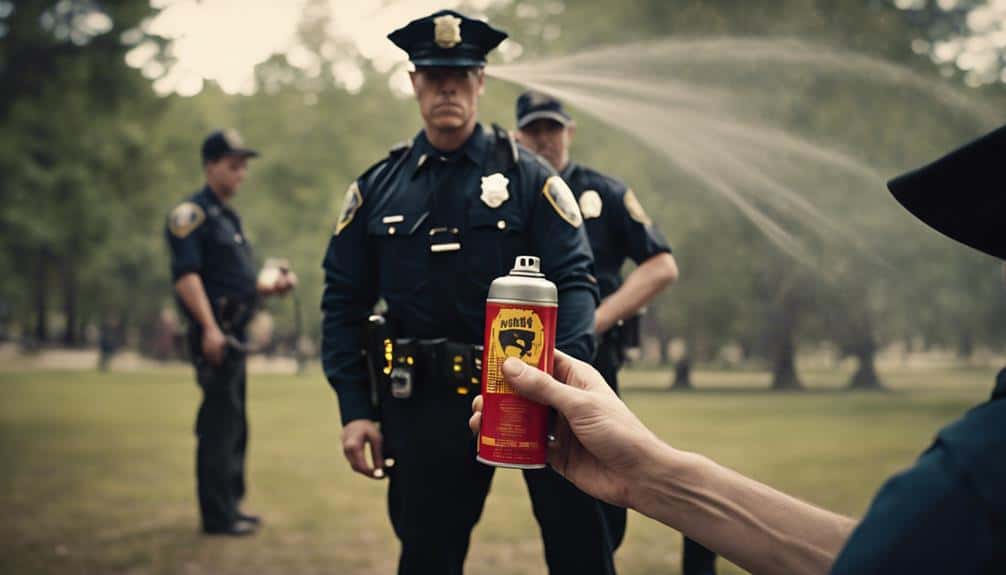
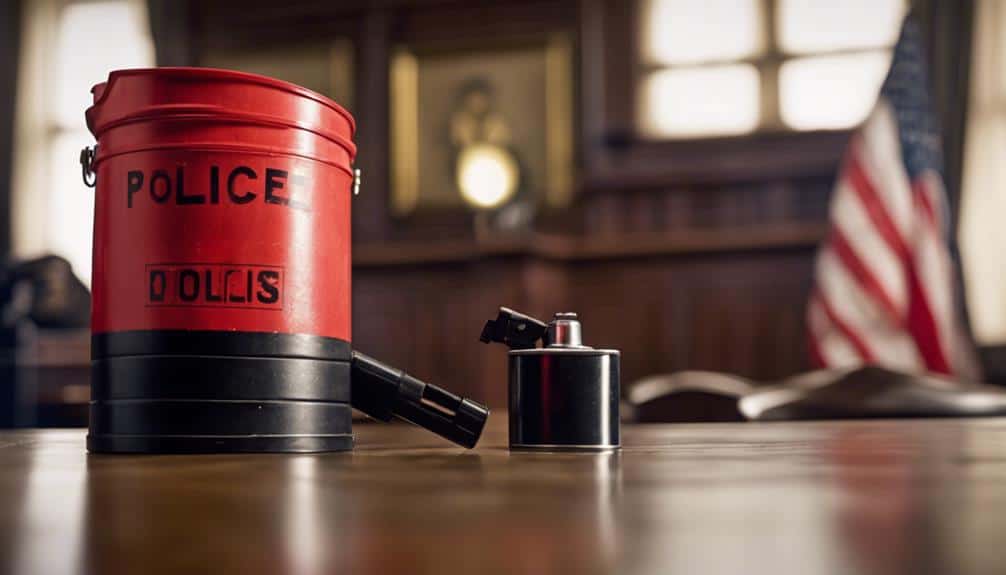
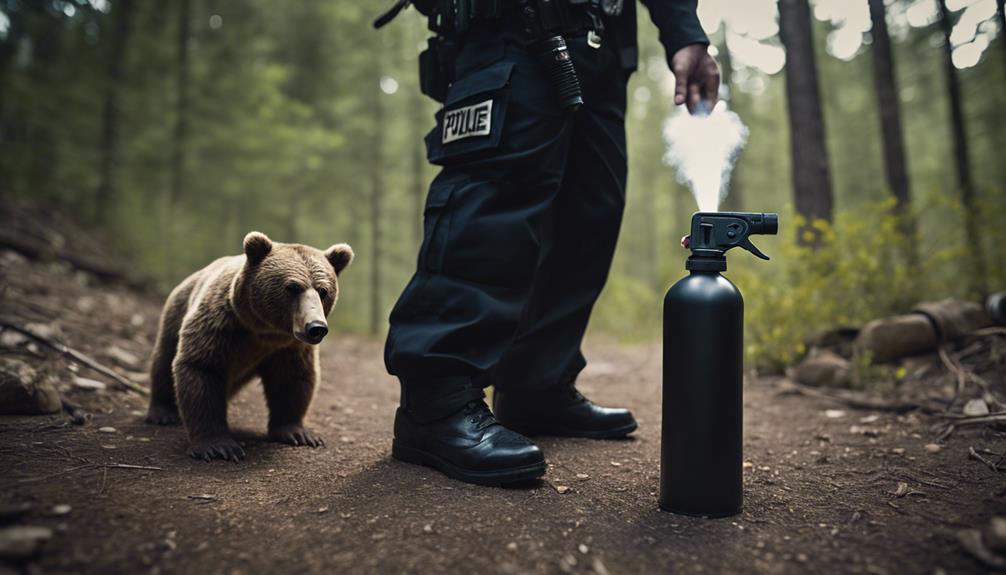
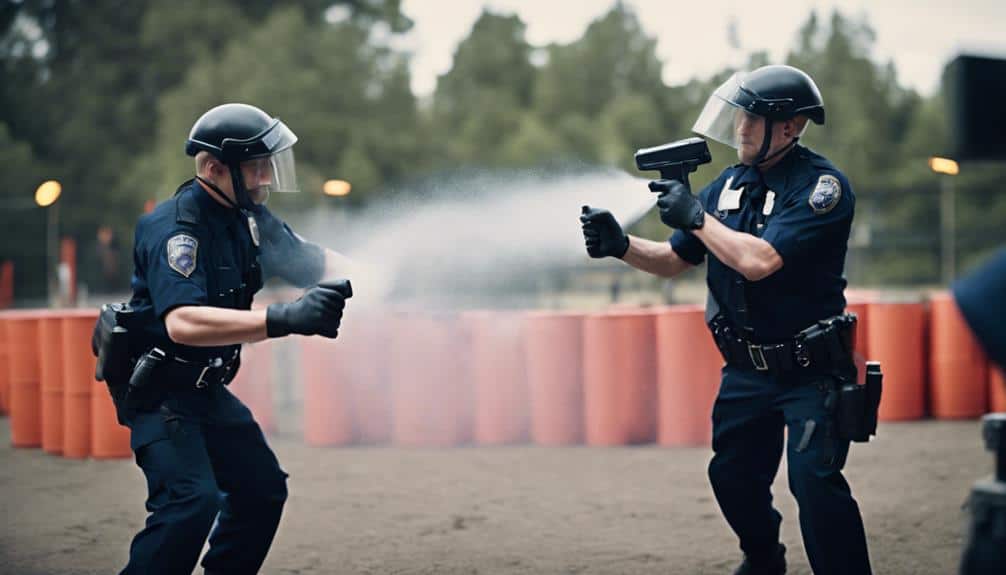
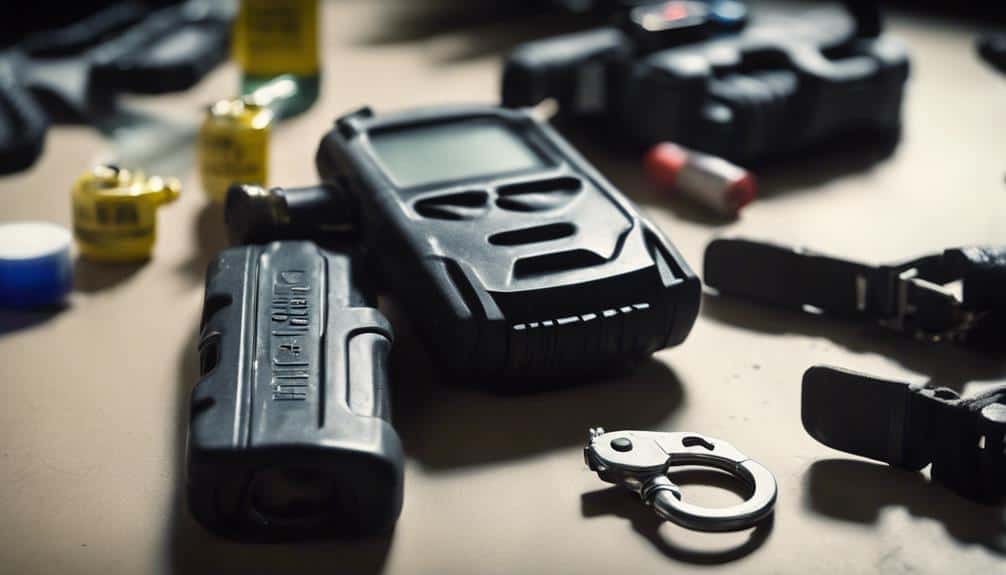

2 Responses